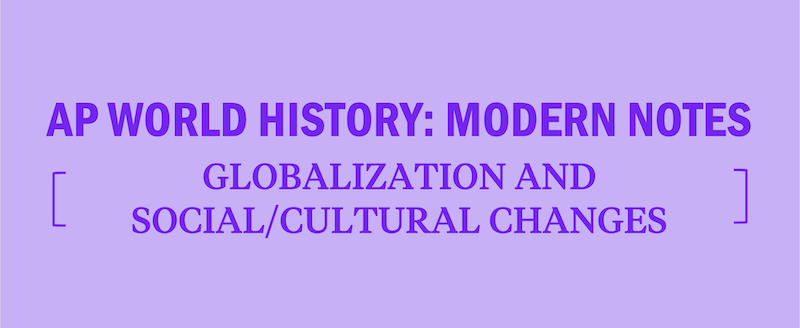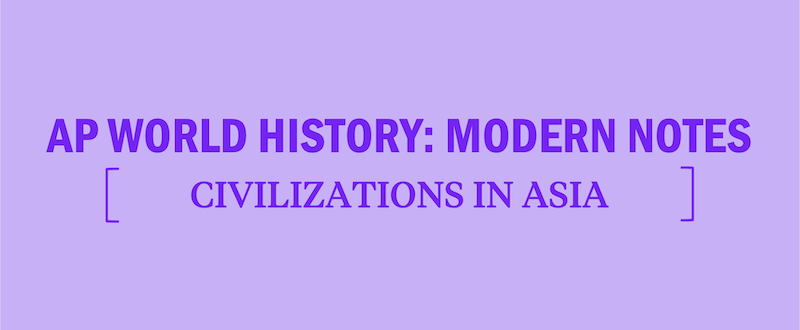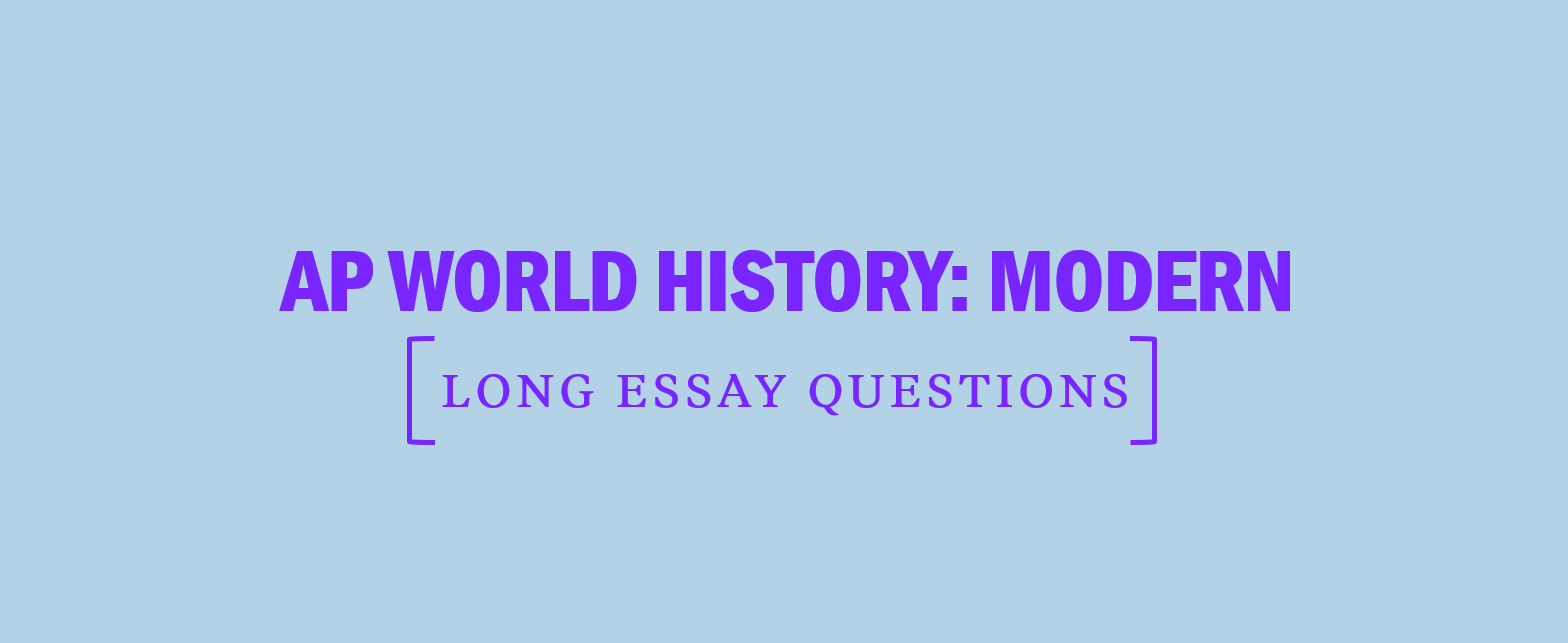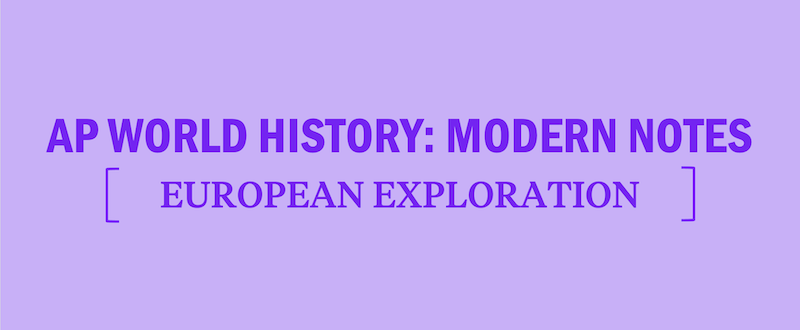Globalization and Social/Cultural Changes of the 20th-21st Centuries—AP World History: Modern Notes
The 20th and 21st centuries brought about huge global social and economic changes. Read on to learn about globalization and trade, the fight for racial and gender equality, religious development and internationalization as you prepare for the AP World History: Modern Exam.
Table of Contents
Globalization
More than ever before, the world in the twentieth century became interconnected through trade, cultural exchange, and political interaction on a mass scale. By century’s end, capitalism and free trade stood unrivaled as world-ordering systems. Western nations still dominated in the areas of finance, trade, culture, and technology. However, even this supremacy began to be challenged by rising regional powers like China and India, as well as cultural and technological powerhouses like Japan and South Korea.
The ongoing problem of establishing international law and order did not end with the creation of the United Nations. Regional groups and treaty organizations, with echoes of the ancient tradition of defensive leagues and alliances between nations, do much to channel and direct global exchange.
Trade Organizations
Trade organizations are tasked with regulating trade and investment. The following are some post–World War II trade organizations that are important context for the Cold War and the post–World War II economy.
| Organization | Description |
| World Bank | Created by the United States to ease reconstruction at the end of World War II, the World Bank assembles and distributes loans from wealthier nations to poorer ones. It uses its power to influence development in ways that favor established patterns and parties in the world economy. |
| International Monetary Fund (IMF) | A postwar U.S. creation that coordinates monetary exchange rates to maintain global financial stability. |
| Organization for Economic Co-operation and Development (OECD) | An economic group originating in postwar Europe that expanded in 1960 to include other Western-oriented capitalist democracies. |
| World Trade Organization (WTO) | Replaced the postwar General Agreement on Tariffs and Trade (GATT) in 1995. WTO is a worldwide group that works to promote unrestricted global trade, following the Free Trade theory first put forth by industrial Britain in the nineteenth century. Just as in the past, free trade for competitive industries runs up against the desire for tariff protection for agricultural producers; countries are more willing to depend on trade partners for manufactured goods than they are for their food supply. |
| Organization of Petroleum Exporting Countries (OPEC) | The first global trade organization that does not represent the institutional dominance of the industrialized West. OPEC was organized in 1960 by four Arab states and Venezuela, as a cartel to raise the price of oil. In 1973, to retaliate against Western support for Israel in the Yom Kippur War, the mostly Muslim OPEC declared an oil embargo against the United States, Britain, and other allies, and raised oil prices worldwide. The short-term effects on the world economy were harsh, but in the long term OPEC lost influence as oil companies found new reserves outside of the group’s control. |
| Asian Infrastructure Investment Bank (AIIB) | Created by China in the 2010s, the AIIB resembles the World Bank in terms of operation, with a particular focus on facilitating infrastructure development in the Asia-Pacific region. It uses its power in ways to advance Chinese influence as a counterweight to the United States in the World Bank. |
Regional Organizations
Regional organizations have formed to protect local interests. Unlike economic associations, these groups often represent less powerful and formerly colonized areas in opposition to Western pressures.
| Organization | Description |
| Association of Southeast Asian Nations (ASEAN) | Formed in 1967 to accelerate economic progress and promote political stability in the nations of the Southeast Asian archipelago. In recent years, it has expanded relations with neighboring regional superpowers like India, China, Japan, and Australia. |
| European Union (EU) | Formed from the European Community in 1993 in an effort to strengthen European economic trade relations and balance the influence of the United States. It has worked to smooth the reabsorption of formerly communist Eastern states into a larger but still Western-oriented Europe. Part of its policy has been to form an economic superpower equal to the United States through the adoption of a single multinational currency, the Euro. |
| Organization of American States (OAS) | The postwar successor of Western Hemisphere conferences that go back to the 1890s. It has been torn between a sense of mutual security in the face of threats from outside the hemisphere and internal conflicts mostly involving Latin American suspicion of U.S. dominance. |
| North American Free Trade Agreement (NAFTA) | Involved the United States, Canada, and Mexico, and enacted in 1994 to remove trade barriers between these countries. To some degree, it was rooted in the economic reforms of the Reagan Administration, which sought to bolster the North American market. |
| Arab League | Includes 22 Arabic-speaking Muslim nations from northwest Africa to the Persian Gulf. Since 1945, it has tried to coordinate regional responses to a continual series of crises in the Middle East and northern Africa. |
| Organization of African Unity (OAU) | Begun in 1963 as sub-Saharan Africa rapidly gained independence from Britain, France, and Belgium. Along with providing coordination and cooperation among member states, the OAU explicitly supported the end of white minority and colonial rule in the continent. With no military force and a policy of noninterference, the OAU was ineffective in stopping wars or human rights violations among its members. In 2002, it was replaced by the African Union (AU), which attempts to emulate the EU with tighter monetary and military bonds among member states. |
Social and Cultural Changes
Racial Equality Efforts
In 1900, W. E. B. Du Bois declared that “the world problem of the twentieth century is the prob- lem of the color line,” and his analysis has stood the test of time. The vast majority of inhabitants in colonies controlled by the white nations of Europe and America were people of color. They received varying degrees of civil and social rights, depending on class and situation, but in almost no cases were they held to be equal in status or ability to the white population. Added to this was the oppression of black and brown minority populations in white settler colonies in the Americas and Australasia. Much of the global fight for independence and national identity can be examined in a racial context, where racial inequality is overthrown along with imperialism. Some important examples of the struggle for racial equality include:
- The negritude movement among Francophone African intellectuals in the 1930s, rejecting assimilation and advocating solidarity among black Africans around the world.
- Afrocentrism among African Americans in the United States during the civil rights era, seeking to correct the Eurocentrism in history, literature, and social studies produced by dominant European and American culture.
- The Civil Rights Act of 1965 in the United States, culminating in a mass movement by American blacks and liberal whites to repeal segregation and white supremacy laws.
- The Brazilian Constitution of 1988, emphasizing civil liberties and criminalizing racial prejudice and speech against minorities, including the large Afro-Brazilian population.
Changing Gender Roles
Before 1914, the Western world held few professional opportunities for women. Most educated women were relegated to childrearing, nursing, or teaching, while working-class women had long been employed in domestic work or light industry. The fight for female suffrage in the West saw its first successes in New Zealand, Australia, and Finland at the turn of the century. Women’s participation in the industrial and professional labor forces during World War I changed more minds. In most of Europe and the United States, women became voters between the 1920s and 1940s. In the prosperous 1920s, fashion and popular culture helped create a new image of the modern middle-class woman—free from some of the constraints of traditional gender roles. World War II further advanced women’s image as workers, citizens, and even soldiers, but peacetime saw a backlash as women were expected to return to homemaking and low-prestige, part-time jobs in the service economy. In less developed parts of the world, only the most adventurous or high-status women were visible in public life, even as industrialism and urbanization offered up more opportunities to work outside the home.
In the 1960s and 1970s, the Western world experienced a sexual revolution, challenging traditional gender norms, marriage as an institution, and the nuclear family. Related factors included greater access to convenient birth control, liberalized divorce and property laws, countercultural rebellion, and the availability of more lucrative service-sector jobs. Since the 1970s, issues of accessible and affordable child care and equal pay for equal work have been debated but not fully resolved. The realms of politics, law, and medicine have become more open to women in the last half of the twentieth century, while successful female leaders, such as in Israel, India, and the U.K., have demonstrated that national-level politics is no longer an all-male domain.
The experiences of Western societies should not be considered the sole benchmark to measure the twentieth century. Many communist societies instituted important legal reforms for women, such as the 1950 marriage law in China which granted free choice of partners. The Soviet Union also placed a great deal of emphasis on scientific research, which was facilitated by a push to recruit candidates for technical schools regardless of gender. Even in the postcommunist era, Russian women are far more involved than their Western counterparts in the field of scientific research. In both Eastern Europe and the rest of the former Soviet bloc, feminism in the Western sense of the term is sometimes seen as a foreign ideology, as the former communist world developed socially and politically along different lines than the West. In parts of the developing world, changes to gender roles have varied. However, many traditional customs still prevail there as in other largely rural and preindustrial areas.
Religious Development
Traditional religious devotion declined in much of the developed world during the twentieth century, leading to a rise in secular agnosticism and humanism, as well as liberal Christianity and Judaism. New forms of spirituality also developed from blending Eastern and Western traditions. Liberation theology in Latin America reinterpreted Catholicism as an aggressive social reform movement, to the disapproval of the Vatican. However, many communities of faith have turned to fundamentalist forms of religion as a result of globalization, reacting against the changes to traditional beliefs and customs. The shift toward fundamentalism has occurred in factions of all the major religions throughout the world.
Internationalization
As the world becomes more and more connected, distinctions and barriers between cultures have become blurred and weakened. Western entertainment companies (in particular movie and music producers) have spread worldwide, carrying Western cultural ideas along with them. American brands like McDonald’s, Coca-Cola, and Kentucky Fried Chicken can be found in most parts of the world today. Western vendors of finance, technology, scholarship, business expertise, architecture, and engineering have helped spread ideas about individualism, consumption, self-fulfillment, and family roles to areas with sometimes radically different approaches to life. This trend has been characterized as cultural imperialism, replacing the political and physical imperialism of the past with something more insidious and invasive.
Globalization, on the other hand, has enabled cultural diffusion to become multidirectional. Tour- ism, immigration, and the Internet have allowed consumers worldwide to have opportunities to appreciate arts, foods, and other cultural markers from around the world. Latin American soap operas, South Korean K-Pop, and Japanese anime are just some of the products in this global marketplace, popular not just in the West but elsewhere as well. Sports have also become more internationalized, with the Olympics and the World Cup competitions enjoying popularity in all regions of the world. In addition, the rise of social media has made it easier than ever for people all around the world to interact.






